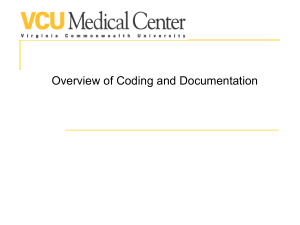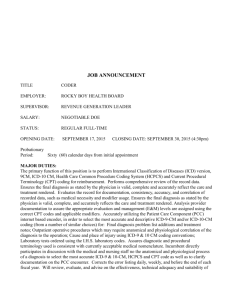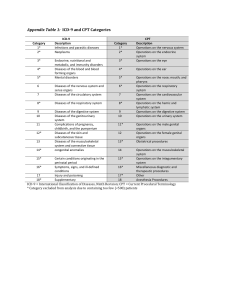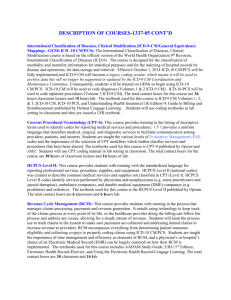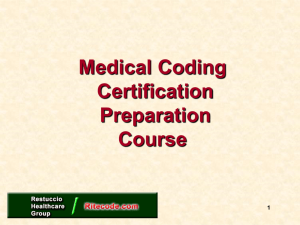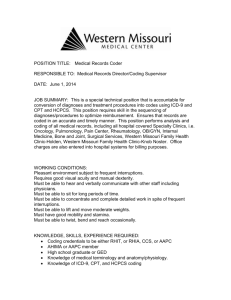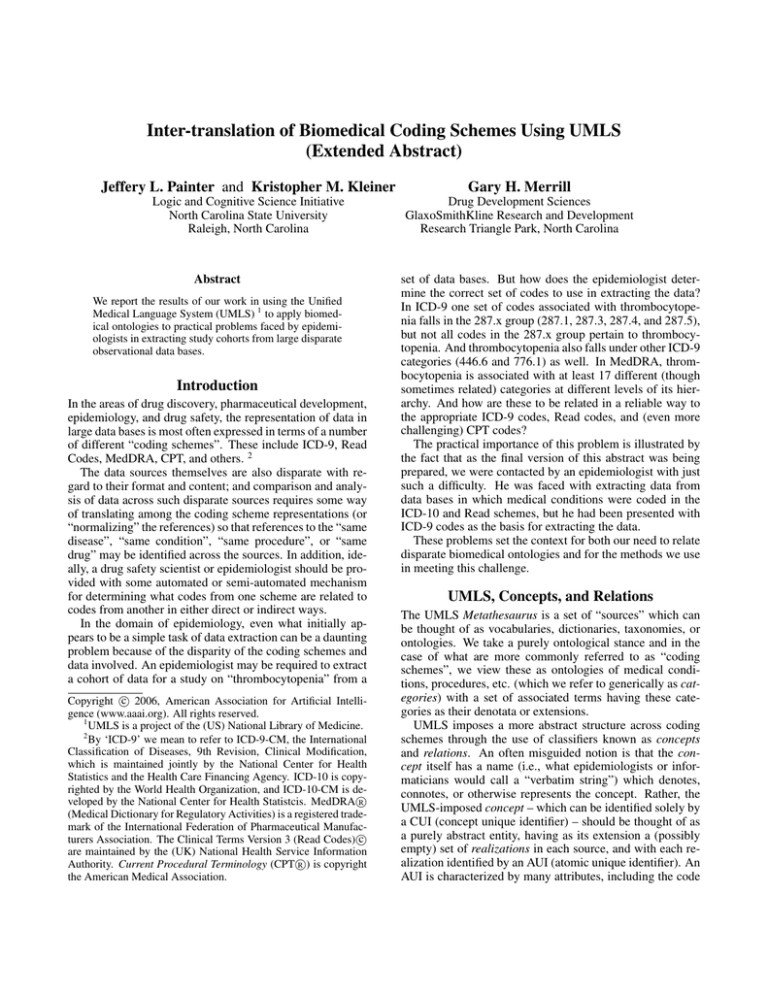
Inter-translation of Biomedical Coding Schemes Using UMLS
(Extended Abstract)
Jeffery L. Painter and Kristopher M. Kleiner
Gary H. Merrill
Logic and Cognitive Science Initiative
North Carolina State University
Raleigh, North Carolina
Drug Development Sciences
GlaxoSmithKline Research and Development
Research Triangle Park, North Carolina
Abstract
We report the results of our work in using the Unified
Medical Language System (UMLS) 1 to apply biomedical ontologies to practical problems faced by epidemiologists in extracting study cohorts from large disparate
observational data bases.
Introduction
In the areas of drug discovery, pharmaceutical development,
epidemiology, and drug safety, the representation of data in
large data bases is most often expressed in terms of a number
of different “coding schemes”. These include ICD-9, Read
Codes, MedDRA, CPT, and others. 2
The data sources themselves are also disparate with regard to their format and content; and comparison and analysis of data across such disparate sources requires some way
of translating among the coding scheme representations (or
“normalizing” the references) so that references to the “same
disease”, “same condition”, “same procedure”, or “same
drug” may be identified across the sources. In addition, ideally, a drug safety scientist or epidemiologist should be provided with some automated or semi-automated mechanism
for determining what codes from one scheme are related to
codes from another in either direct or indirect ways.
In the domain of epidemiology, even what initially appears to be a simple task of data extraction can be a daunting
problem because of the disparity of the coding schemes and
data involved. An epidemiologist may be required to extract
a cohort of data for a study on “thrombocytopenia” from a
c 2006, American Association for Artificial IntelliCopyright gence (www.aaai.org). All rights reserved.
1
UMLS is a project of the (US) National Library of Medicine.
2
By ‘ICD-9’ we mean to refer to ICD-9-CM, the International
Classification of Diseases, 9th Revision, Clinical Modification,
which is maintained jointly by the National Center for Health
Statistics and the Health Care Financing Agency. ICD-10 is copyrighted by the World Health Organization, and ICD-10-CM is deR
veloped by the National Center for Health Statistcis. MedDRA
(Medical Dictionary for Regulatory Activities) is a registered trademark of the International Federation of Pharmaceutical Manufacc
turers Association. The Clinical Terms Version 3 (Read Codes)
are maintained by the (UK) National Health Service Information
R is copyright
Authority. Current Procedural Terminology (CPT)
the American Medical Association.
set of data bases. But how does the epidemiologist determine the correct set of codes to use in extracting the data?
In ICD-9 one set of codes associated with thrombocytopenia falls in the 287.x group (287.1, 287.3, 287.4, and 287.5),
but not all codes in the 287.x group pertain to thrombocytopenia. And thrombocytopenia also falls under other ICD-9
categories (446.6 and 776.1) as well. In MedDRA, thrombocytopenia is associated with at least 17 different (though
sometimes related) categories at different levels of its hierarchy. And how are these to be related in a reliable way to
the appropriate ICD-9 codes, Read codes, and (even more
challenging) CPT codes?
The practical importance of this problem is illustrated by
the fact that as the final version of this abstract was being
prepared, we were contacted by an epidemiologist with just
such a difficulty. He was faced with extracting data from
data bases in which medical conditions were coded in the
ICD-10 and Read schemes, but he had been presented with
ICD-9 codes as the basis for extracting the data.
These problems set the context for both our need to relate
disparate biomedical ontologies and for the methods we use
in meeting this challenge.
UMLS, Concepts, and Relations
The UMLS Metathesaurus is a set of “sources” which can
be thought of as vocabularies, dictionaries, taxonomies, or
ontologies. We take a purely ontological stance and in the
case of what are more commonly referred to as “coding
schemes”, we view these as ontologies of medical conditions, procedures, etc. (which we refer to generically as categories) with a set of associated terms having these categories as their denotata or extensions.
UMLS imposes a more abstract structure across coding
schemes through the use of classifiers known as concepts
and relations. An often misguided notion is that the concept itself has a name (i.e., what epidemiologists or informaticians would call a “verbatim string”) which denotes,
connotes, or otherwise represents the concept. Rather, the
UMLS-imposed concept – which can be identified solely by
a CUI (concept unique identifier) – should be thought of as
a purely abstract entity, having as its extension a (possibly
empty) set of realizations in each source, and with each realization identified by an AUI (atomic unique identifier). An
AUI is characterized by many attributes, including the code
associated with it in its particular coding scheme (source)
and a verbatim string that would commonly be used by medical professionals.
Understanding how relationships available within the
Metathesaurus can be utilized is key to creating a robust and
meaningful system. For our purposes, we have classified the
most useful (binary) relations among objects into categories
based on their strengths. In direct strong relations, a single
CUI is realized by two AUIs in the same source; in indirect
strong relations, the CUI is realized by AUIs in two different
sources; and in indirect weak relations, there is a potentially
complex AUI(realization)/CUI(concept) chain between the
AUI relata. This classification of relations allows epidemiologists to assess the likely significance of connections among
codes within and across schemes.
While the first two types of relations are easily found, the
weak relations prove to be more challenging and possibly
more useful. Although the indirect strong technique does
allow for the transcending of sources, it is limited in its capacity to transcend disparate types of coding schemes. An
example of this is found when we wish to discover codes for
medical conditions (ICD-9) that are associated with medical
procedures (CPT).
Procedures and Conditions
Developing a strategy of mapping between procedure and
condition concepts has been a major challenge in our
project. Certain coding schemes are similar in both content
and organizing structure, which makes for simple translation. However, this is not always the case. We illustrate the
difficulties that arise when translating between two dissimilar coding schemes by considering the case of ICD-9 and
CPT.
ICD-9 codes represent medical conditions (e.g. infectious
and parasitic diseases, injury and poisoning, etc.), while
CPT codes represent medical procedures (e.g. x-ray, CT
scan, appendectomy, etc.). At first it may seem possible to
relate medical conditions to procedures by assuming that a
form of the verbatim string of the condition (“appendicitis”)
will appear as a part of the verbatim string of the procedure
(“appendectomy”). This assumption does not hold in most
cases, and so the question of how to relate the two coding
schemes remains.
Additionally, coding schemes often differ in their hierarchical structures. ICD-9 has a “source asserted” hierarchy
(i.e., one that is part of ICD-9 itself), while CPT lacks such
an intrinsic hierarchy. As a consequence, UMLS imposes a
hierarchy on CPT, and this is represented in the MTHCH 3
source.
This dissimilarity in structure provides further difficulties in the inter-translation of coding schemes. Certainly
it seems clear that many medical procedures are associated
with some medical condition or other (such as the association of a biopsy with cancer), but identifying meaningful
associations of this sort is non-trivial. First, it is impossible
to use hierarchical relations (such as parent, child, or sibling)
3
By ‘MTHCH’ we mean the Metathesaurus Hierarchical CPT
Terms, which is maintained by the National Library of Medicine.
to establish such relations by ascending in one of these ontologies to a high “conceptual level” via the CUI hierarchy
and then descending to concept (CUI) realizations in the alternate coding scheme. UMLS was not designed to meet this
particular goal. UMLS itself only provides semantically oriented mappings of objects in and between ontologies. And
consequently it is infeasible to start with a CPT (procedure)
category, ascend to a higher level, and then “project” the
concept at that level “downward” onto an ICD-9 (condition)
category without broadening the concepts involved to the
point of meaninglessness. Another way of describing this
situation is to make the (on reflection, rather obvious) observation that a medical condition concept cannot be realized
by a medical procedure.
As a result, the higher-level categories in ICD-9 are difficult at best to associate with CPT categories. We explored
methods that would take advantage of the relations which
provide a link between coding schemes. Our hope was to
make use of other relationships provided by UMLS to map
between procedures and conditions. UMLS provides a number of non-hierarchical relationships, but these are not uniformly or predictably distributed across its sources. Though
we found non-hierarchical UMLS relations to be useful in
mapping among “domain homogeneous” ontologies, they
proved to be wholly insufficient for reliably establishing relationships among heterogeneous ontologies such as ICD-9
and CPT; there are no direct relations of any kind between
ICD-9 and CPT, and only a limited number of indirect relations between AUIs from the two sources sharing the same
CUI.
Recalling that our primary purpose in relating procedure
to condition codes is to provide a knowledgeable user with
suggestions for meaningful associations, we have decided
on a more empirically oriented approach to discovering such
relations. Our current research direction is to investigate the
use of very large observational data bases of patient medical
histories in this regard. By using data mining or machine
learning techniques on such information sources we should
be able to infer common relations among procedures and
conditions. These empirically inferred relations may then
be used in our application to present the user with a set of
meaningful procedure/condition suggestions from which to
choose.
Methodology in a Practical Context
We have described our general approach to using UMLS
for the purpose of “mapping” among biomedical coding
schemes in the domains of medical conditions, signs, symptoms, and procedures. While our methodology is of some
interest in the areas of knowledge representation and knowledge engineering, our primary goal is to use this methodology to achieve beneficial practical results in the areas of drug
discovery and drug safety. Accordingly, our methods are
being used as the basis of a highly-interactive user-oriented
application called CodeSlinger that will enable epidemiologists to explore relations among medical condition and procedure concepts, and to develop and manage “sets” of such
concepts and their related codes. CodeSlinger itself will be
the subject of future publications.

